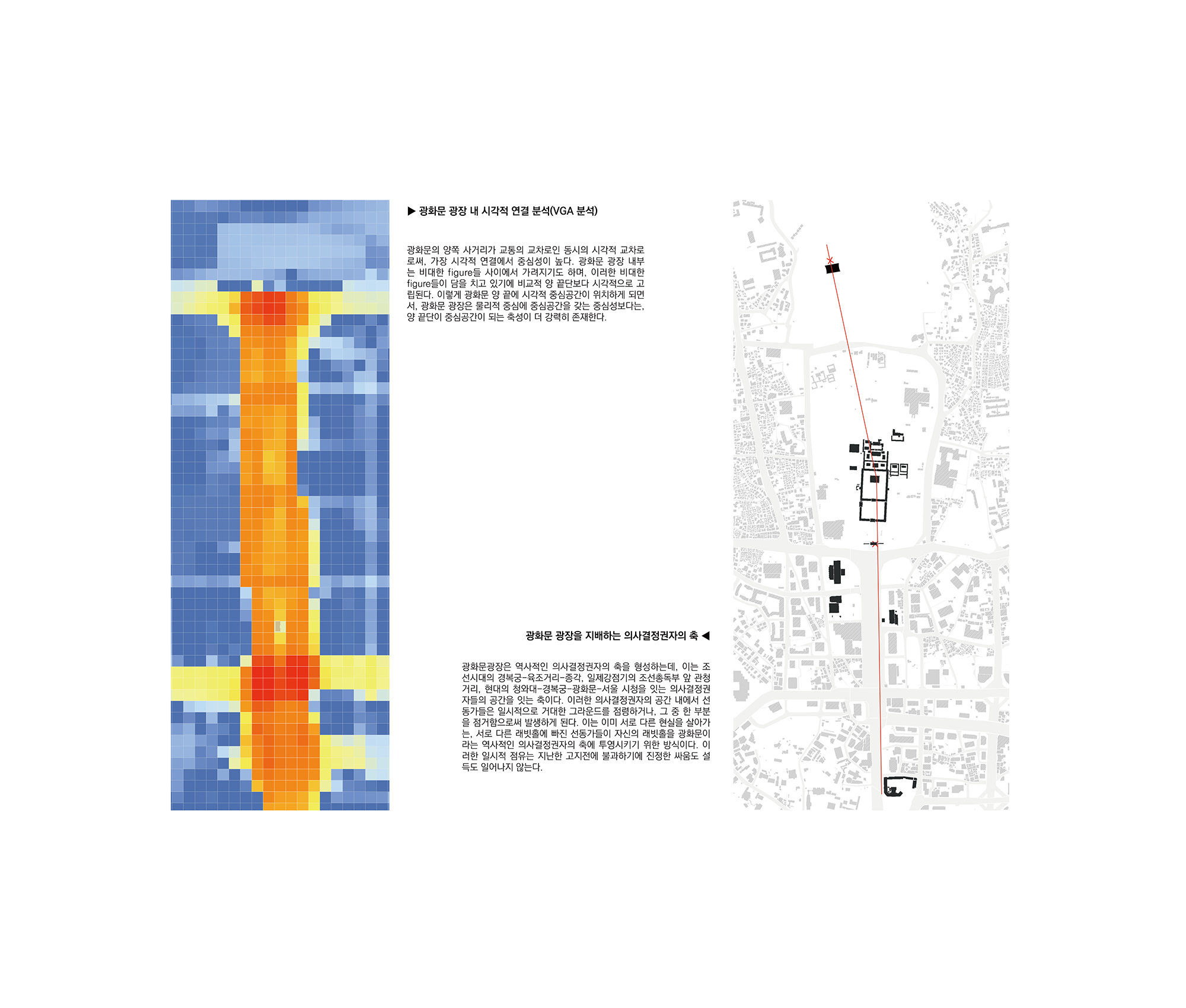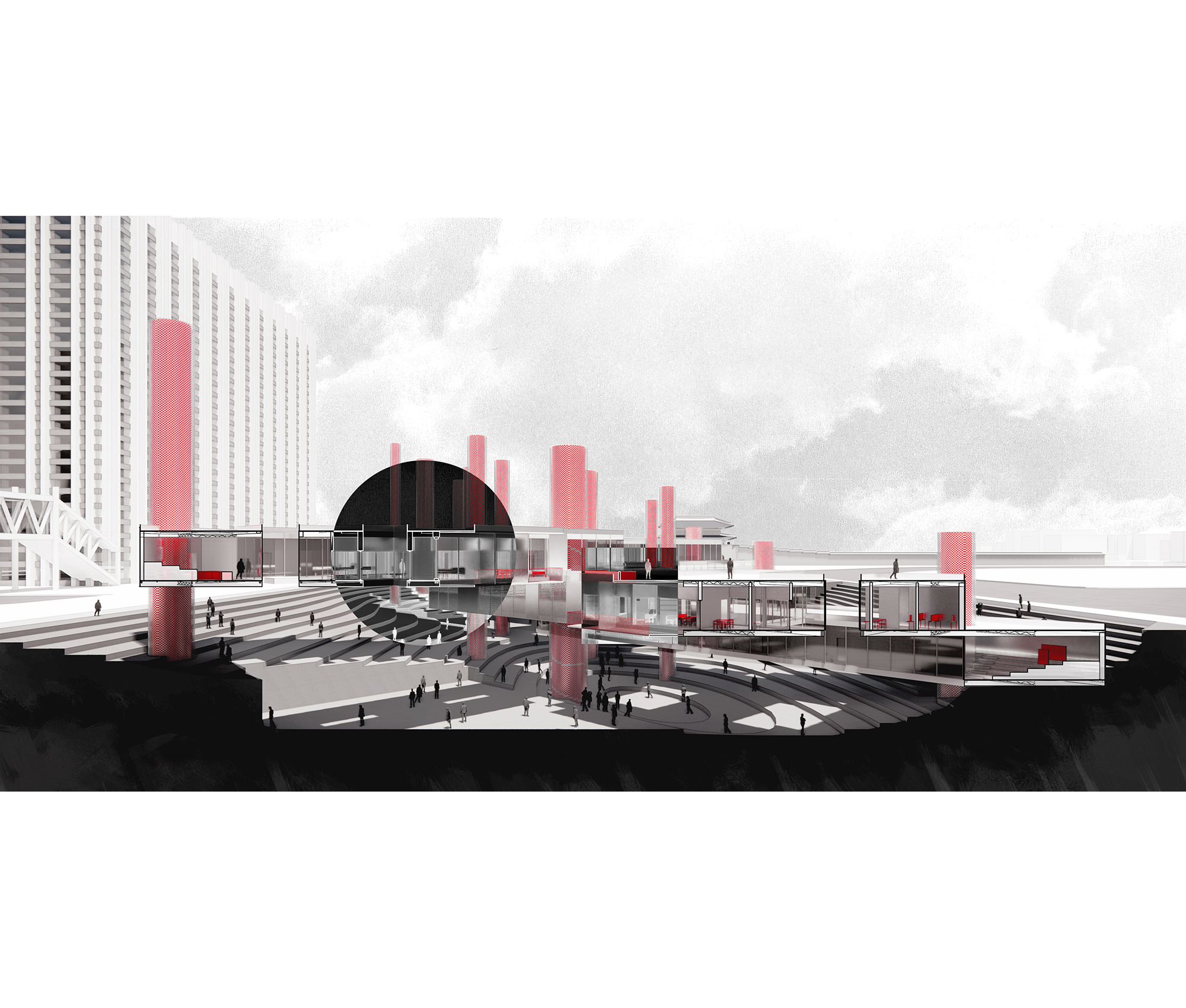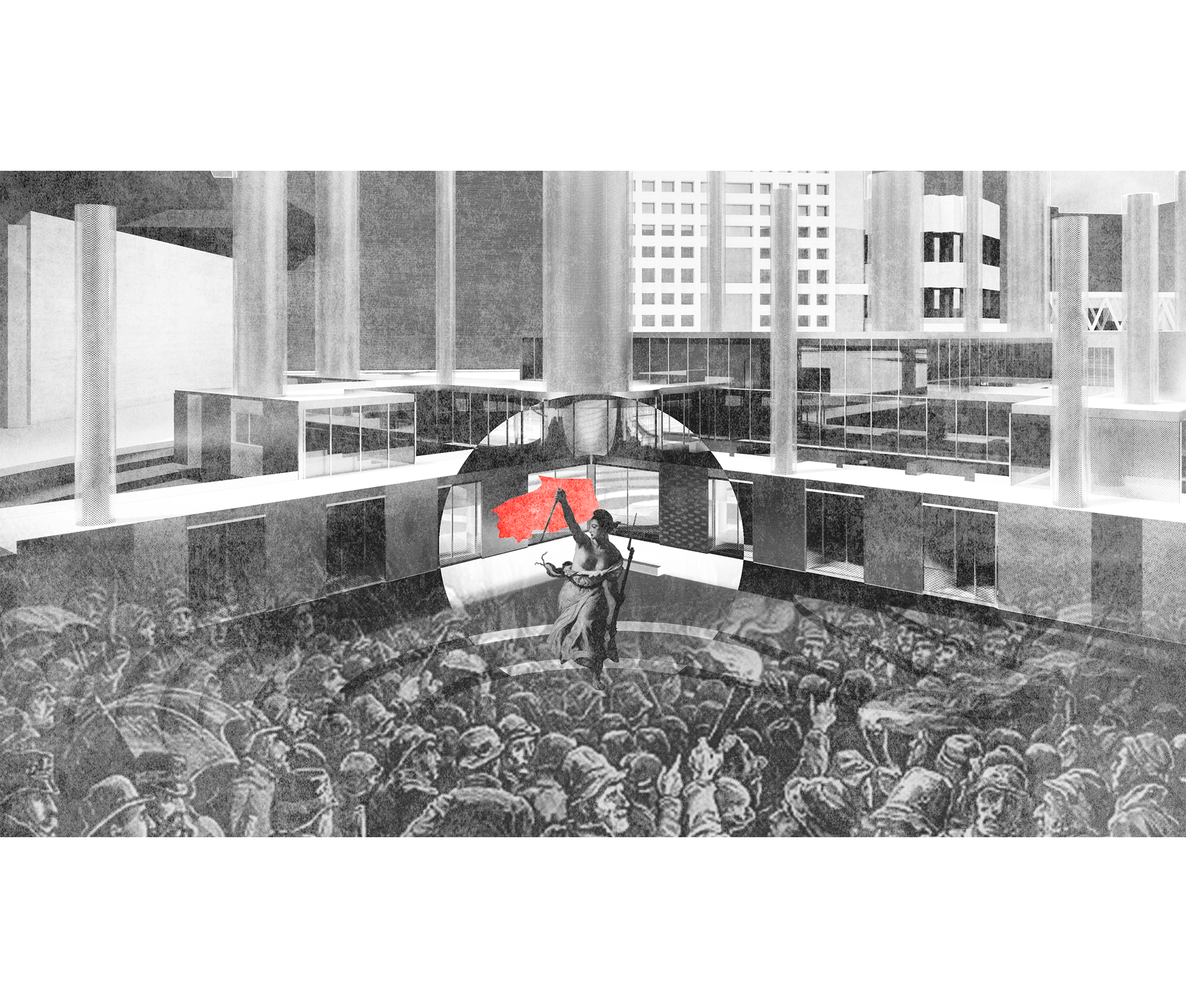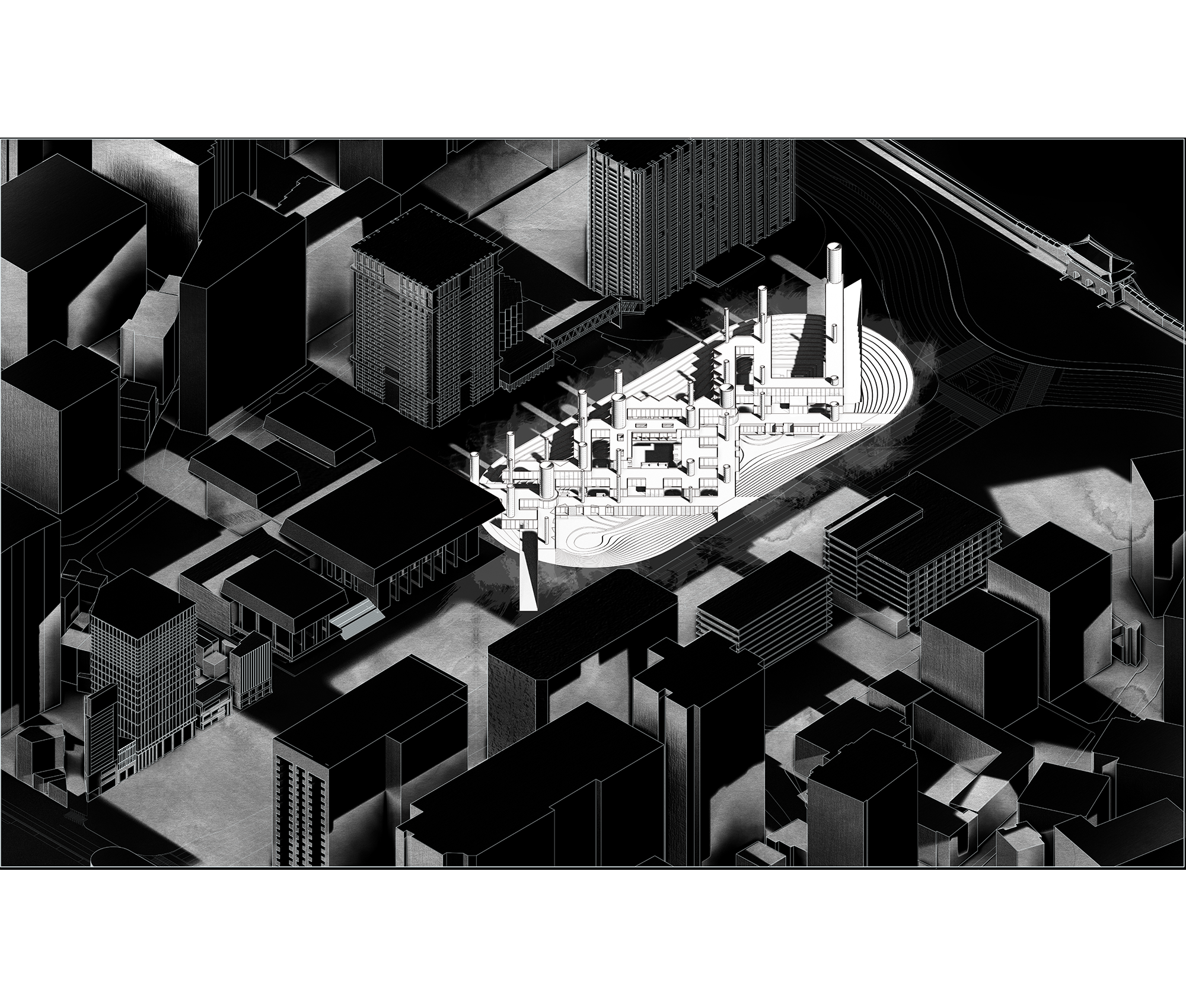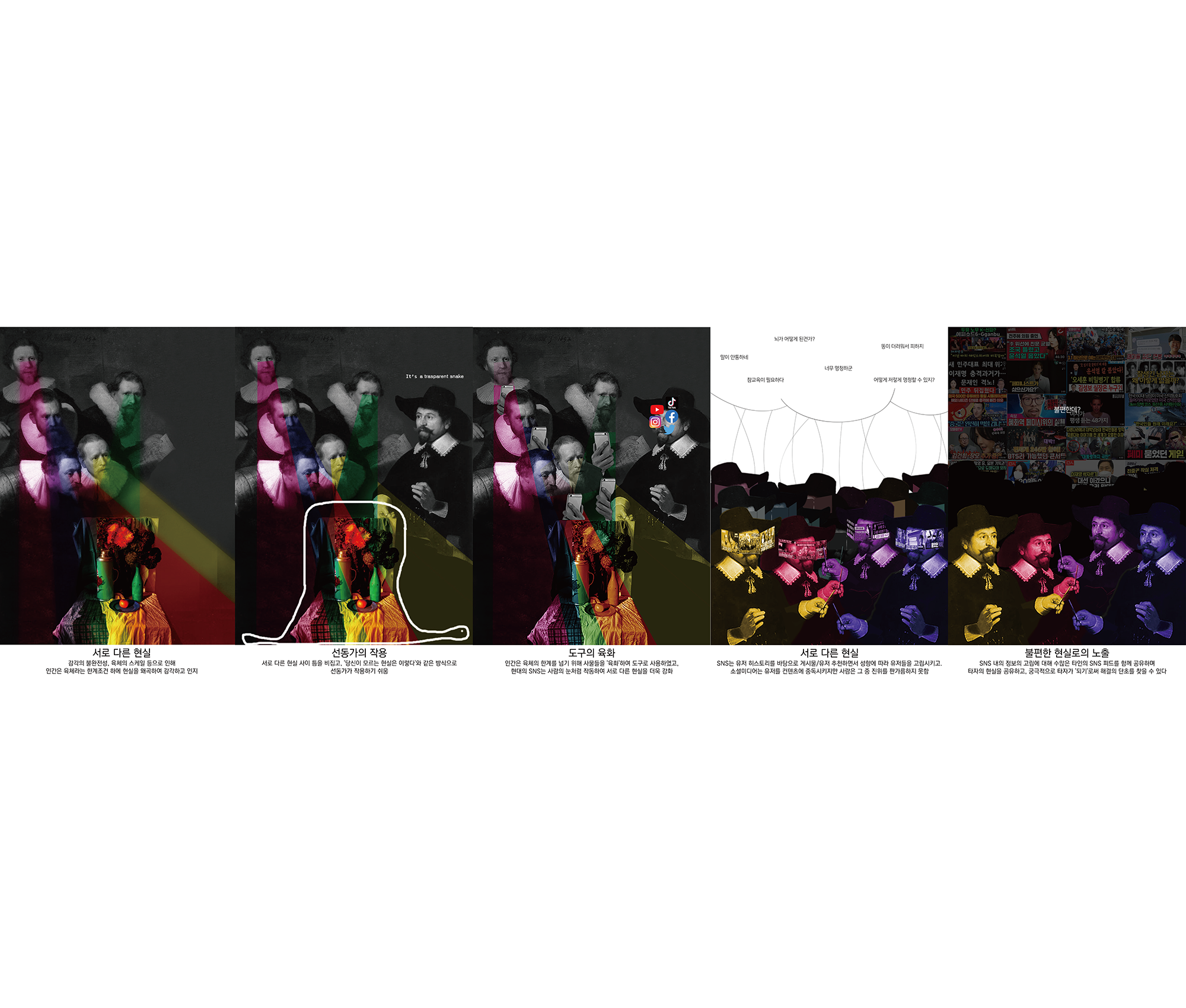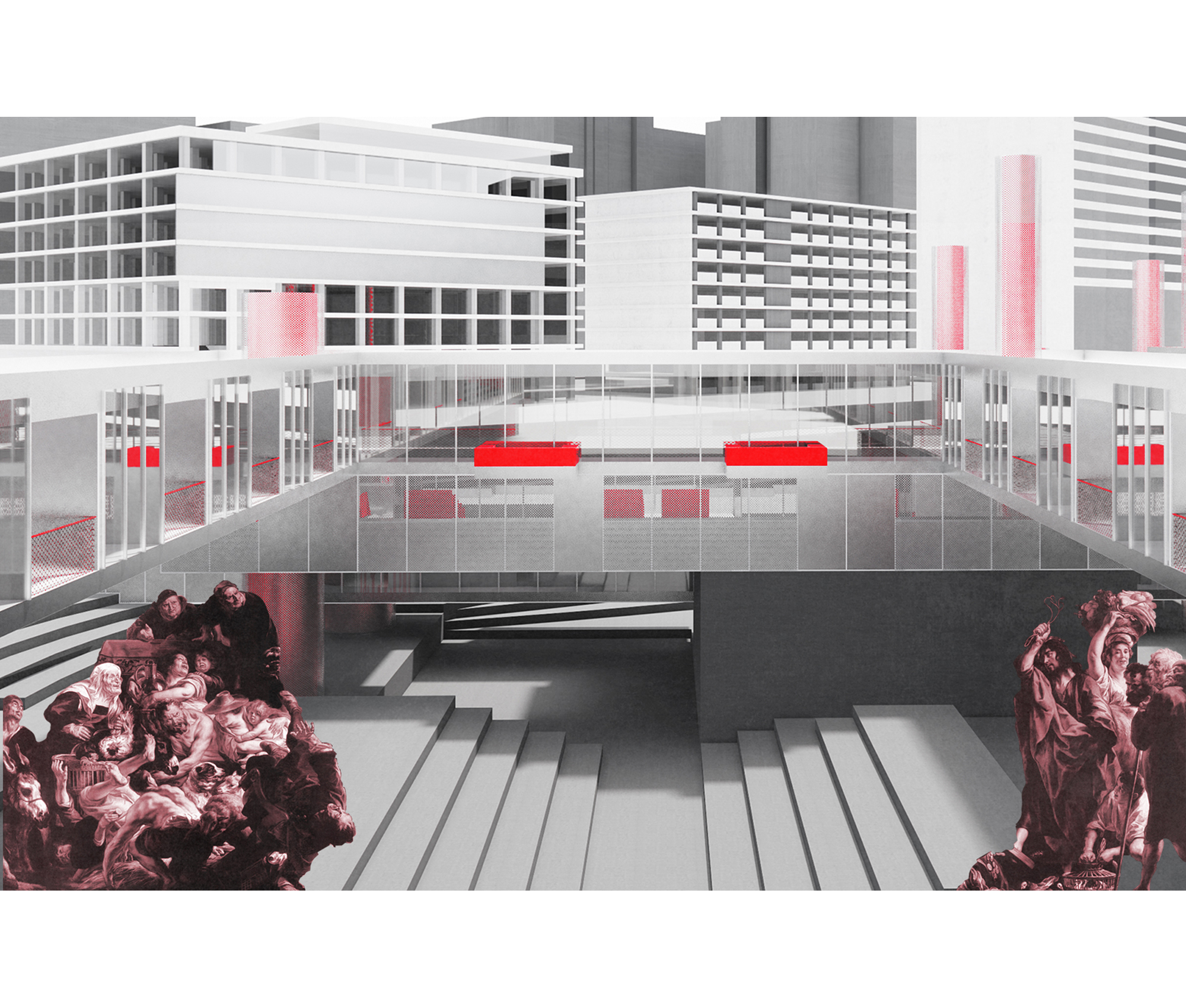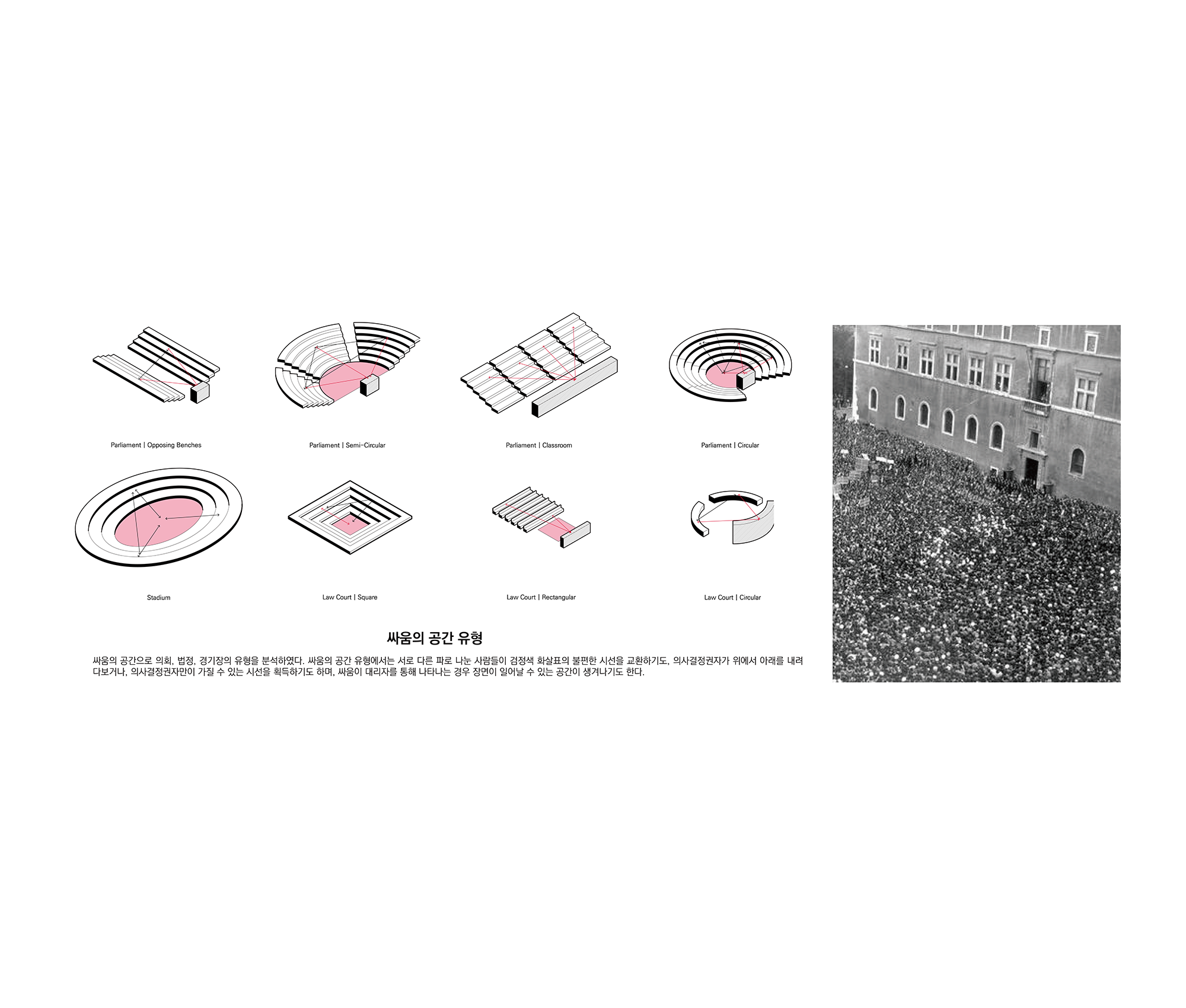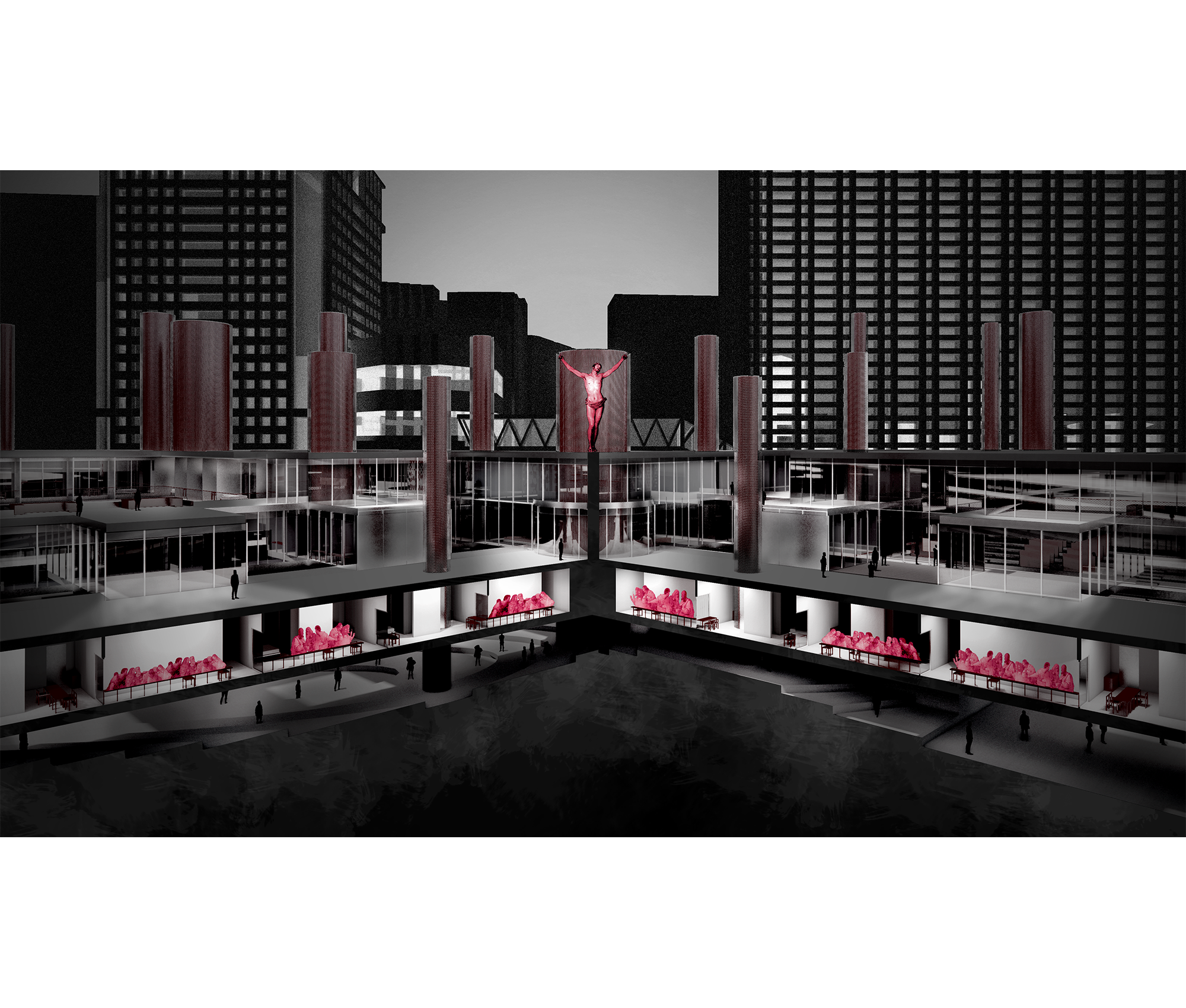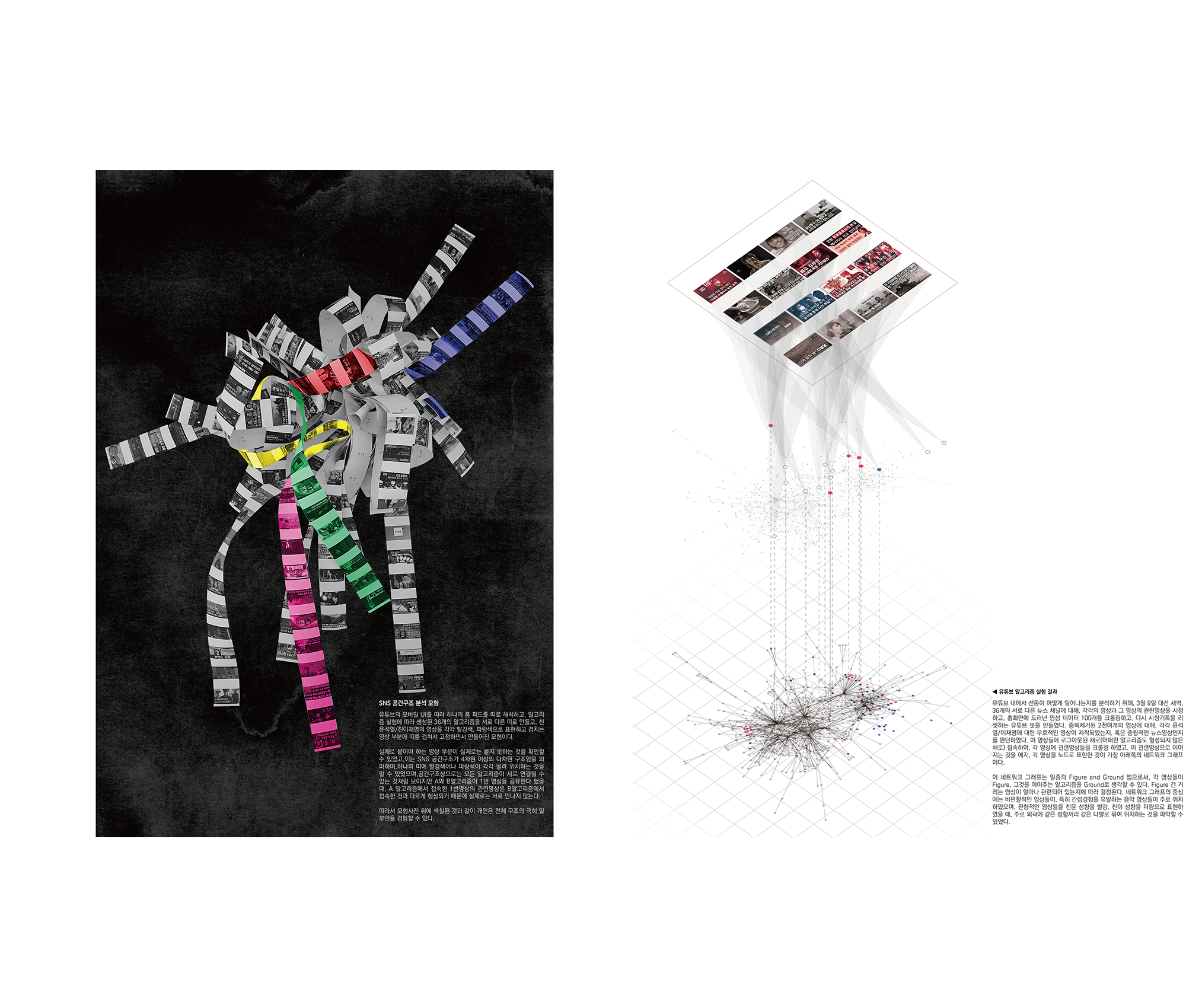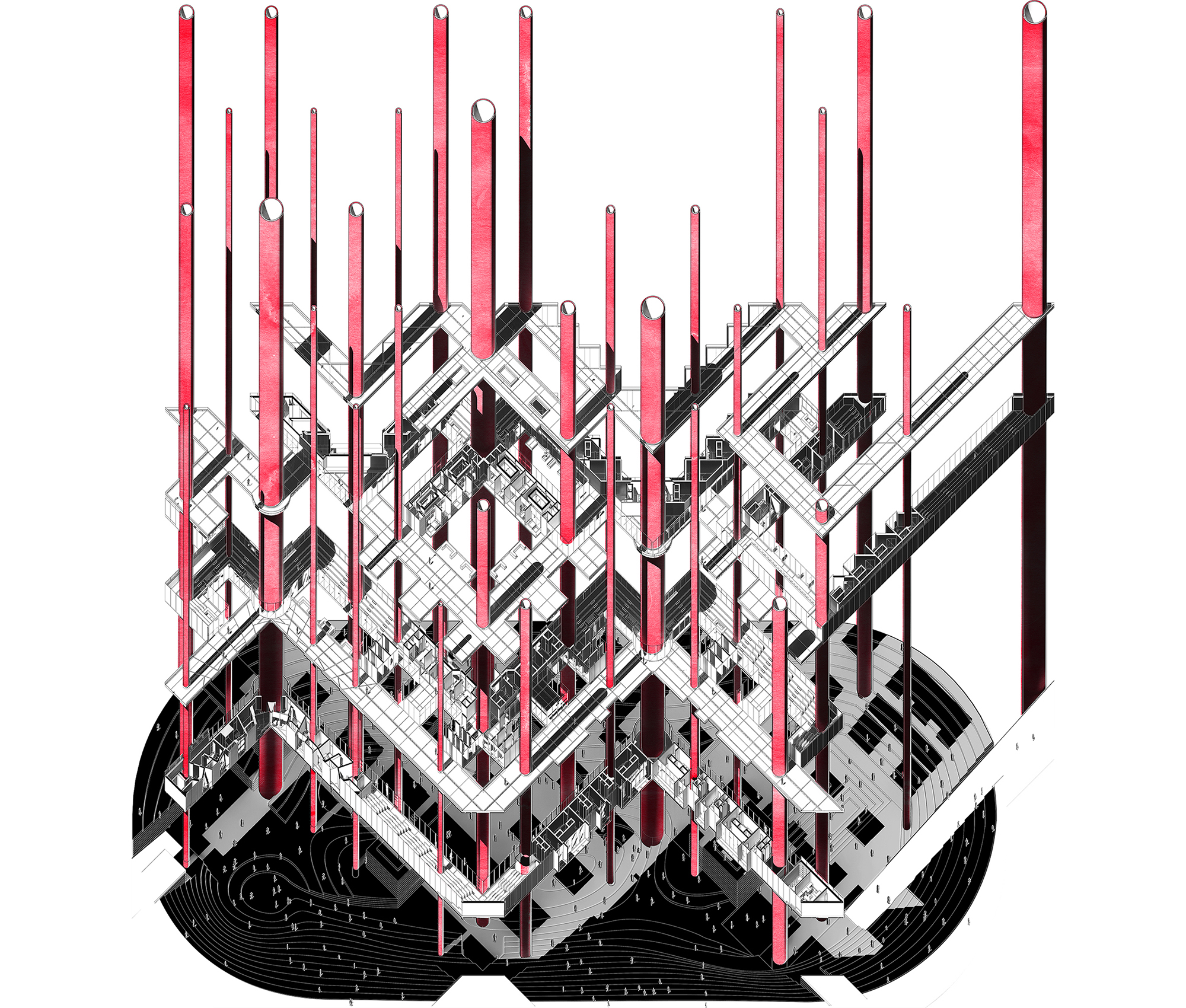이현정
Lee Hyunjeong
인간은 자신의 살로 인해 돌을 서로 다르게 인식합니다. 감각의 불완전성, 육체의 스케일 등 육체라는 한계로 인해 인간은 서로 다르게 돌을 인식하여 서로 다른 현실을 살아갑니다. 이 서로 다른 현실 사이 틈을 비집고, 선동가들은 자신의 말과 행동으로 타인의 현실을 장악해나갑니다. 인간은 또한 돌을 도구화하여, 자신의 살과 같이 사용하게 됩니다. 이는 현대사회에서, 현대인이 세상의 소식을 대부분 sns로 접하게 되어, 현대인은 sns를 자신의 눈과 같이 사용하게 되는 것과 같다고 생각하였습니다.
sns는 정크스페이스의 속성들을 가지는데, 계속해서 공간이 바뀌며, 화면이라는 평면에 sns의 공간과 사용자의 모든 감각이 종속되고, 계속해서 공간이 변화하기에 장소성을 형성할 수 없어 기억이 쉽게 휘발됩니다. 물리적 세계 내의 정크스페이스는 계속해서 사람들이 이동하게 만들면서 지치게 한다면, sns는 클릭 한번으로 원하는 공간에 갈 수 있고 스크롤 한번으로 공간을 축소시킬 수 있기에, sns는 사람들을 지치지도 않게 하며 중독시켜 나갑니다.
3월 9일 대선 당일 새벽, 유튜브 봇을 만들어서 리셋된 유튜브 계정으로 서로다른 36개의 뉴스채널 각각의 영상을 시청한 36개의 서로다른 알고리즘을 형성하고 각 알고리즘에 따른 영상을, 그리고 각 영상들 화면에 나타나는 관련영상을 크롤링하는 리서치를 실행하였으며, 각 영상 간의 연결을 분석한 결과, 다음과 같은 네트워크 그래프가 나타났습니다. 네트워크의 중심에는 비편향적인 영상들-음악이나 드라마와 같은 영상들이 나타난 반면, 특정 대선후보에 편향적인 영상-빨간 점은 윤석열 편향 영상, 파랑점은 이재명 편향 영상-의 점들은 네트워크 외곽에 위치하였고, 빨간 점은 빨간점끼리, 파란점은 파란점끼리 같은 다발로 묶여 유튜브 내에서 선동적인 영상들이 각각 래빗홀을 형성하고 있는 것을 관찰할 수 있었습니다.
SNS는 현대인을 중독시키는 동시에 개개인에 맞춤화된 편향적인 내용만을 제공하기에 sns에서의 선동가들은 서로 다른 현대인에게 각자만의 빠져나올 수 없는 래빗홀과 같은 현실을 제공하게 됩니다. 이 서로 다른 래빗홀에 빠진 sns 유저들은 타자의 현실을 인식할 수 없기에, 자신의 현실을 이해하지 못하는 타자를 ‘멍청’하다고 표현하며, 타자의 현실에 노출될 때 이를 ‘불편’하다고 표현하게 됩니다. 서로 다른 개인이 화해를 하기 위해서는 서로를 온전히 인식하고 자신의 현실을 지키기 위해 투쟁하여야 하나, 타자의 현실 혹은 타자 자체를 인식하지 못하는 사람들은 타자와 싸울 이유 조차를 모르거나, 싸울 의지조차 상실하게 됩니다.
반면, 광화문광장에서의 선동은 sns에서의 선동과 다르게 일어납니다. 광화문광장은 역사적인 의사결정권자의 축을 형성하는데, 이는 조선시대의 경복궁-육조거리-종각, 일제강점기의 조선총독부 앞 관청 거리, 현대의 청와대-경복궁-광화문-서울 시청을 잇는 의사결정권자들의 공간을 잇는 축입니다. 이러한 의사결정권자의 공간 내에서 선동가들은 일시적으로 거대한 그라운드를 점령하거나, 그 중 한 부분을 점거함으로써 발생하게 됩니다. 이는 이미 서로 다른 현실을 살아가는, 서로 다른 래빗홀에 빠진 선동가들이 자신의 래빗홀을 광화문이라는 역사적인 의사결정권자의 축에 투영시키기 위한 방식입니다. 이러한 일시적 점유는 지난한 고지전에 불과하기에 진정한 싸움도 설득도 일어나지 않습니다.
저는 이번 프로젝트를 통해 진정한 싸움터를 제공하고 싶었습니다. 제가 생각한 진정한 싸움이란, 불편한 타자와의 각자의 현실을 지키기 위한 투쟁입니다. 이는 이미 래빗홀에 빠진 존재들에게는 서로 다른 존재를 인식하고, 보고싶지 않아도 보고, 듣고싶지 않아도 들어야만하는 강제성과 폭력성이 수반되는 방법으로 발생한다고 생각하였습니다. 그리고 그 투쟁이 단순히 일시적이 아닌 일상적으로 발생하였을 때만 새로운 관계와 새로운 의미를 형성하여 타자의 현실을 경험할 수 있는, 타인의 래빗홀을 경험할 수 있는 어떠한 존재로의 ‘되기’가 발생한다고 생각하였습니다. 이러한 일상적인 되기는 비로소 선동가들이 그곳에 거주할때 극대화 될것이라 판단하였고, 이를 위해 저는 광화문에 선동가의 레지던스를 마련하였습니다.
이 선동가의 레지던스에서는 선동가의 되기뿐 아니라, 시민의 되기 또한 존재합니다. sns와 광화문이라는 기존의 공간에서는 선동가와 피선동가만의 위계만이 존재했다면, 제 프로젝트에서는 시민이 선동가를 지지하는 것뿐만 아니라, 발화의 공간을 점유하여 새로운 선동가가 될 수도 있고, 선동가의 공간을 위에서 내려다보며 스스로 판단할 수 있는 의사결정권자의 시선 또한 가질 수 있는 새로운 시민으로써의 되기 또한 발생합니다.
이 새로운 시민과 선동가의 공간은 기존의 광화문의 축에 반발하면서 생겨납니다. 선동가들이 불편함을 마주하는 강제적 공간을 마련하기 위해 그리드를 사용하면서도 이를 의사결정권자의 축을 45도로 비틀어 발생시킵니다. 또 그리드와 대립하는 어휘로 지하공간이 발생하는데, 이 지하공간은 그리드에서 발생하는 여러 주거의 마주함을 지원하디 위해 싸움의 공간을 여러 유형으로 풀어내며, 그 유형사이의 연결을 자유로이 합니다. 매스는 광화문광장에서 정부서울청사쪽으로 진행될수록 높아지는데, 매스의 첫 레벨의 옥상이 지면 레벨에 마주하면서 시민은 매스 위의 의사결정권자의 공간과 지하에서 선동가를 지지하거나 직접 선동할수 있는 공간을 스스로 선택하여 이동할수 있게 합니다.
싸움의 공간으로 의회, 법정, 경기장의 유형을 분석하였으며, 싸움의 공간 유형에서는 서로 다른 파로 나눈 사람들이 검정색 화살표의 불편한 시선을 교환하기도, 의사결정권자가 위에서 아래를 내려다보거나, 의사결정권자만이 가질 수 있는 시선을 획득하기도 하며, 싸움이 대리자를 통해 나타나는 경우 장면이 일어날 수 있는 공간이 생겨나기도 합니다. 이러한 공간들은 지하설계와 선동자의 주거가 엮여 드러나며, 서로 다른 주거들은 장면의 유무에 따라 서로 다른 발코니를 가지고, 서로 다른 각도로 배치됩니다. 이 주거에서는 다 함께 공유되는 식탁을 가지거나, 서로의 일상을 지켜봐야하거나, 발코니에 침대가 배치되어 선동가의 일상을 사람들에게 낱낱이 드러나고자 합니다. 이러한 주거는 선동가가 원한다면 자신의 모든 모습을 사람들에게 공개하고 자신을 더욱 드러내고자 할 경우를 지원합니다.
Humans, due to their own flesh, perceive stones in different ways. Due to the limitations of body, such as sensory imperfection and scale of body, humans perceive stones in differently and live in different realities. Through the gaps of different realities, demagogues control the reality of others with their own words and actions. Humans also tool stones, and use them as their own flesh. Likewise in modern society, since modern people perceive most of the news from social network, modern use it as their eyes.
Social network have properties of junkspace, where space and senses of users are subject to 2 dimension, and space consistently changes, which leads to incapability of forming place, and easily volatilized memories. Where junkspace in the physical world keeps getting people moving and getting tired, social network enables humans to go to the space they want with one click and shrink space with one scroll, and in result social network can poison people without getting tired.
Early in the morning of the presidential election on March 9, I created a YouTube bot, which formed 36 different algorithms that watched 36 different news channel videos with a reset YouTube account, and scraped video datas of each algorithm. In the network graph from analyzing how these videos were connected, non-biased videos like music and dramas were shown in the center, whereas videos provocating certain presidential candidates were shown at the outer side of the network. Videos that provocated the same candidate were shown in the same branch, similar to a rabbit hole, which absorbs the users into a biased world of thoughts midst non-biased videos . Social media addict modern people and provide biased content tailored to individuals, so demagogues in social network provide different modern people with a reality like their own inseparable rabbit hole. Because SNS users who fall into these different rabbit holes cannot recognize the reality of others, they describe others who does not understand their reality as "stupid" and describe it as "disturbing" when exposed to the reality of others. In order for different individuals to reconcile, they must fully recognize each other and fight to protect their reality, but those who do not recognize others or the reality of others lose their reason and will to fight.
On the other hand, demagogy in Gwanghwamun Square is different from demagogh on SNS. Gwanghwamun Square forms the axis of the historic decision-maker, which connects Gyeongbokgung-Yukjo Street-Jonggak during the Joseon Dynasty, government-run street in front of the Joseon Governor-General in Japanese colonial era, and modern Cheong Wa Dae-Gyeongbok Palace-Gwanghwamun-Seoul City Hall. Within this axis of decision-makers demagogues are created by temporarily occupying the entire huge ground as a crowd or part of it as a small group of individuals. This is a way for demagogues who are already living in different realities to project their rabbit holes onto the axis of the historical decision-maker called Gwanghwamun. This temporary occupation is just a turf war, so there is no real fight or persuasion.
This project aimed to create a truthful battlefield. A fight becomes only truthful when one fully recognizes others and others' realities and struggles to protect one's own reality from disturbing others. This would only be possible by involving coercion and violence that requires seeing when not wanting to see, hearing when not wanting to hear. In addition, in order for this fight to result in 'becoming', struggle should occur as daily basis, not just temporary, so that it would create a new relationship and a new meaning with others, and 'becoming' a human being able to experience the reality of others, and someone that could experience the rabbit hole of others. This routine would only be maximized when dwelling of demagogues is created in Gwanhwamun, and for this purpose, I set up a residence for demagogues in Gwanghwamun.
In this demagogue's residence, not only 'becoming' of demagogue, but also of citizen exists. If there were only demagogues and non-demagogues in the existing space of SNS and Gwanghwamun, in my project, citizens would not only support demagogues, but also become new demagogues by occupying space of speech, or someone who could look down at them and judge by themselves. This new space for citizens and demagogues is created by protesting against the existing Gwanghwamun axis. The dwelling of agitators use the grid to create a compulsory space to face disturbance, and this grid twists the decision maker's axis at 45 degrees. In addition, the vocabulary that contradicts the grid creates the underground space, which unravels the fighting space into different types to support the encounters of different dwellings occurring in the grid, and frees the connection between those types. The mass rises as it progresses from Gwanghwamun Square to the Seoul Government Complex, where the first level of the roof faces the ground level, allowing citizens to choose from moving between the decision-maker's space upside the mass and the underground space where they can support agitators. From the analysis of types of parliaments, law courts, and stadiums, where people divided into different groups exchange disturbing stares, the decision maker looks down, and the space for scene creating the fight of the representatives. These spaces are interwoven with the underground design and the agitator's dwellings, and the different dwellings are arranged at different angles, with different political balconies depending on the presence or absence of the scene. Some residential units share a table penetrating the walls, watch each other's daily lives, or have beds on the balcony to reveal the daily lives of themselves to people if wanted.
